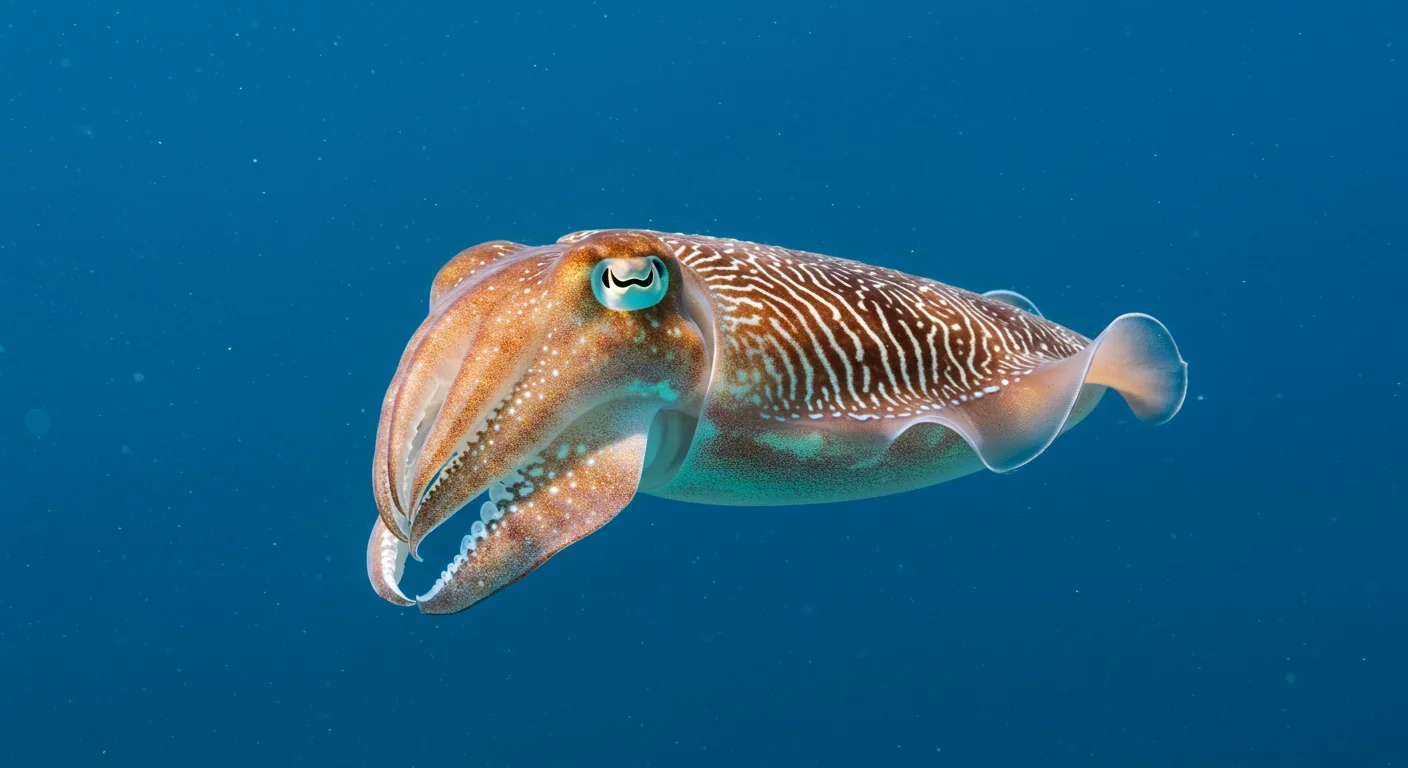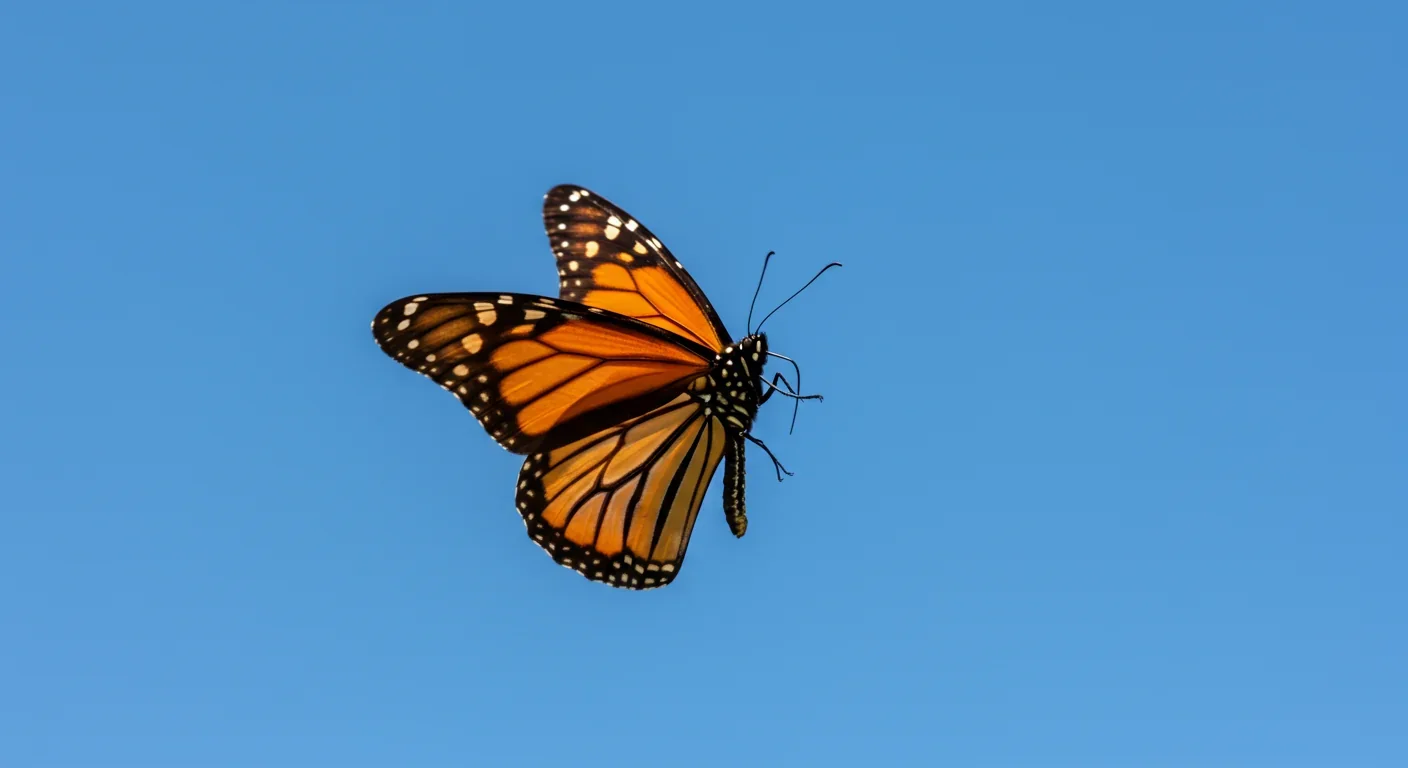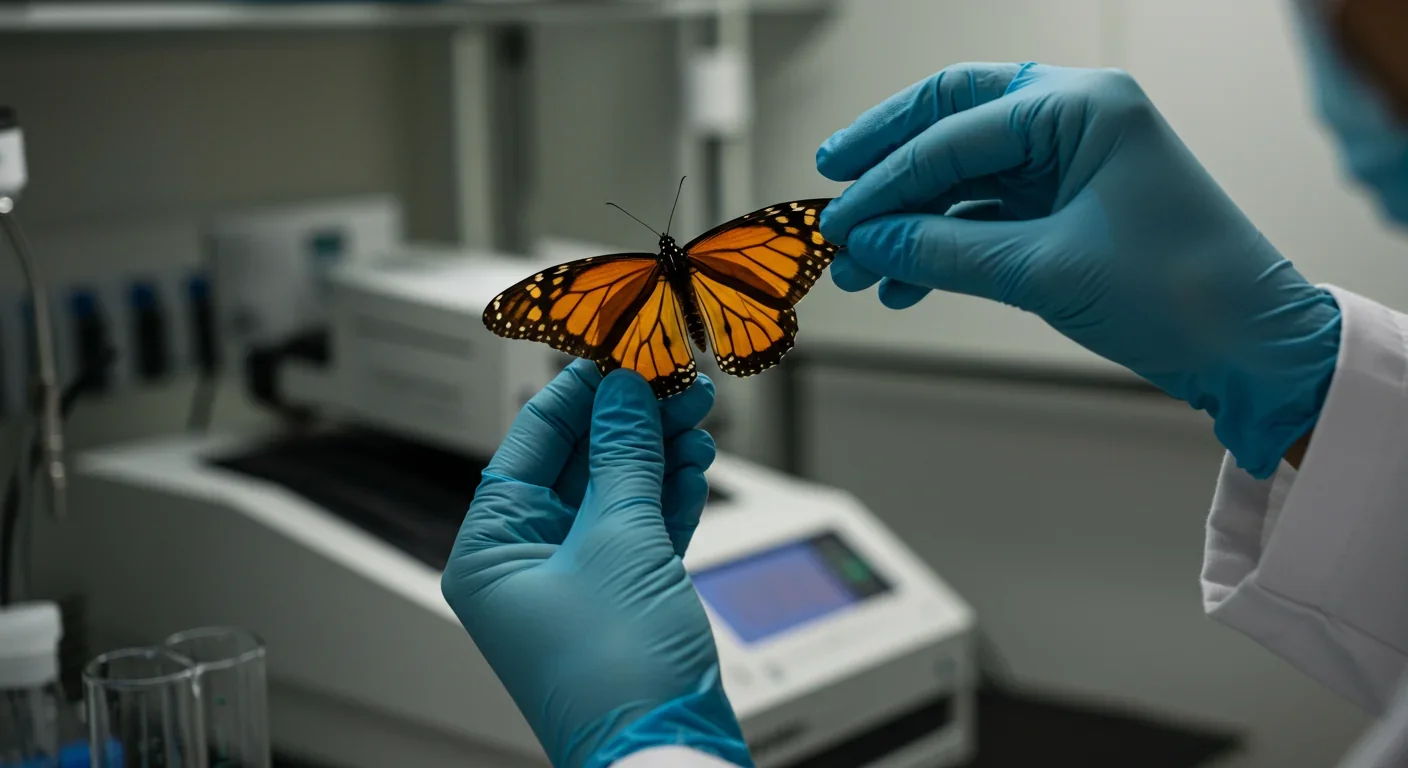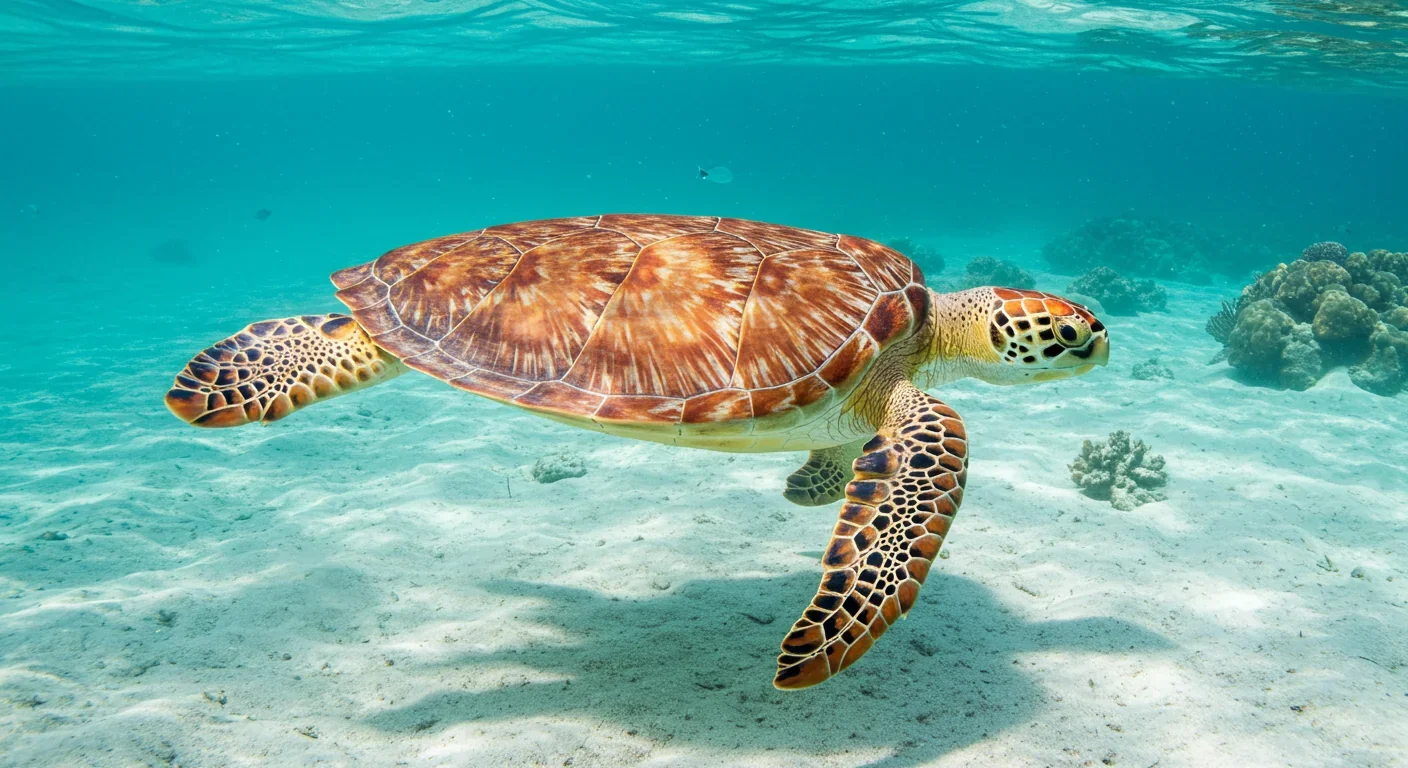Cuttlefish Pass Marshmallow Test: Alien Intelligence Decoded

TL;DR: Animals navigate complex migrations without learning by using inherited spatial knowledge encoded in genes, magnetic imprinting, and social transmission. Monarchs use genetically programmed sun compasses, sea turtles follow magnetic signatures, and some birds teach routes across generations—but these rigid systems face conservation crises as environments change faster than evolution can adapt.

Every autumn, millions of monarch butterflies launch themselves into the sky and head southwest, traveling up to 3,000 miles from Canada and the northern United States to a handful of fir tree groves in central Mexico. Here's what makes this journey remarkable: these butterflies have never been there before. They're three or four generations removed from the ancestors who last made the trip. There are no guides, no older butterflies to follow, no learning period. Yet somehow, they know the way.
This isn't just about monarchs. Loggerhead sea turtles hatch on Florida beaches, swim out into the Atlantic, and spend decades circling the ocean. When it's time to breed, females return—not just to Florida, but often to the exact beach where they were born, a stretch of sand they left 20 or 30 years earlier. Arctic terns fly from pole to pole each year, covering 44,000 miles. European eels born in the Sargasso Sea navigate to European rivers they've never seen, only to return to their birthplace decades later to spawn and die.
For generations, scientists puzzled over how this could work. Memory implies experience, yet these animals navigate perfectly on their first attempt. What they're demonstrating is something far stranger than memory—it's inherited spatial knowledge, routes encoded not in neural circuits built through learning, but in genes, proteins, and biological mechanisms that pass from one generation to the next.
Traditional memory doesn't explain migration. When a monarch butterfly emerges from its chrysalis in Canada, its great-great-grandparents are long dead. There's no opportunity for teaching, no culture to transmit the route, no social learning. The butterfly has never seen the Mexican mountains. Yet when fall arrives and day length shortens, something in its biology activates, and it flies southwest with precision.
This presents a biological puzzle: how do you inherit knowledge of a place you've never been?
The question fascinated Steven Reppert, a neuroscientist at UMass Medical School who spent years studying monarch navigation. "Migratory monarchs are at least two generations removed from those that made the journey the previous fall," he explained. "They have never been to the overwintering sites before, and have no relatives to follow on their way. There must be a genetic program underlying the butterflies' migratory behavior."
How do you inherit knowledge of a place you've never been? This fundamental question challenges our understanding of memory itself.

The breakthrough came from genomics. In 2011, Reppert's team sequenced the monarch genome—273 million base pairs containing 16,866 protein-coding genes. It was the first butterfly genome ever sequenced. Within that genetic library, they found the tools for inherited navigation: genes controlling circadian clocks, visual input processing, juvenile hormone biosynthesis, and expanded families of odorant receptors.
Three years later, another team led by Marcus Kronforst at the University of Chicago compared the genomes of 101 butterflies—some migratory, others from non-migratory populations around the world. What they discovered was striking. Among the hundreds of genes that differed between populations, one stood out: collagen IV α-1, a gene involved in flight muscle formation and function.
Migratory monarchs expressed drastically reduced levels of this gene. The result? More efficient flight muscles that consumed less oxygen and had significantly lower metabolic rates. This wasn't just about endurance—it was about the entire migratory phenotype being switched on or off by genetic changes.
"The results of this study shift our whole thinking about these butterflies."
— Dr. Marcus Kronforst, University of Chicago
What's remarkable is how repeatable this is. Three separate non-migratory monarch populations arose independently across the globe—in Hawaii, the Caribbean, and South America. Each time, similar genetic changes associated with flight efficiency appeared, suggesting migration can be switched on or off through predictable genetic pathways.
This explains the first mystery: migratory behavior itself is genetic. But knowing that you should migrate doesn't explain knowing where to go.
Monarchs navigate using a sun compass, but not a simple one. If you just flew toward the sun, you'd spiral in circles as the sun moved across the sky. Instead, monarchs use something far more sophisticated: a time-compensated sun compass that integrates the sun's position with their internal circadian clock.
Here's how it works: circadian clock genes in the butterfly's brain and eyes create a roughly 24-hour rhythm. This internal clock allows the butterfly to adjust its flight angle throughout the day to maintain a consistent southwestern heading. When the sun is in the east during morning, the butterfly flies one direction relative to it. By afternoon, when the sun has moved west, the butterfly adjusts its angle to continue southwest.
The mechanism was proven through elegant experiments. When researchers disrupted the circadian clock genes or covered one of a monarch's eyes, the butterflies became disoriented, unable to maintain their heading. The system requires both components—sun awareness and timing—working together.
But there's an additional layer. Monarchs have an ultraviolet-sensitive photoreceptor in the dorsal rim region of their eyes. This allows them to detect polarized skylight, providing navigational information even on cloudy days when the sun isn't directly visible. The UV opsin protein creates a backup navigation system, a biological redundancy that makes the journey more reliable.

Sea turtles use a different inherited navigation system—one that might be even more mysterious than the monarch's sun compass. Loggerhead sea turtles can sense the Earth's magnetic field, and they appear to use it like a map with latitude and longitude lines.
Here's what researchers discovered: the Earth's magnetic field varies across the planet in two ways—intensity and inclination (the angle at which field lines intersect the surface). These create unique magnetic signatures at different locations. When a loggerhead turtle hatches and crawls into the ocean, it imprints on the magnetic signature of its natal beach.
Decades later, when it's time to nest, the turtle navigates back to that magnetic signature. A 2022 study in Current Biology analyzed 19 years of loggerhead nesting data along Florida's coast and found something astonishing: as the Earth's magnetic field slowly drifted over time, the turtles' nesting locations shifted with it. They weren't returning to a physical location—they were returning to a magnetic signature, even as that signature moved along the coastline.
Sea turtles don't return to a place—they return to a magnetic signature, following invisible lines even as the Earth's field shifts beneath them.
But magnetic navigation alone isn't enough to pinpoint a small island in a vast ocean. Research on green turtles migrating to Ascension Island—a tiny speck in the South Atlantic—revealed a two-phase strategy. First, turtles use magnetic cues to navigate to the general vicinity of the island, following magnetic isolines (contours of equal magnetic intensity) that curve through the ocean. Once close, they switch to chemical cues, following waterborne odor plumes back to the island.
This multi-modal approach is elegant: use the stable, large-scale magnetic map to get close, then use local chemical signatures for precision. The system is robust enough that even after a 25-year absence—during which the magnetic isolines have shifted due to geomagnetic drift—the turtles' magnetic route still intersects with the island's odor plume 72 to 100 percent of the time.
The biological mechanism is still being worked out. Turtles have magnetite in their brains, tiny crystals of magnetic material that could act as sensors. Some researchers believe cryptochromes—the same light-sensitive proteins that help monarch butterflies detect magnetic fields—might be involved in sea turtle magnetoreception as well.
Not all inherited migration is purely genetic. Some species have found a hybrid solution that combines innate direction with learned routes—and this reveals something crucial about the flexibility of navigational inheritance.
A 2024 study published in Movement Ecology analyzed 50 years of bird migration data from 122 North American species. The researchers wanted to understand how birds were shifting their ranges in response to climate change. What they found was revealing: birds that migrate in flocks—especially mixed-age flocks where juveniles travel with experienced adults—showed significantly faster range shifts than solitary migrants.

Flocking species adjusted their non-breeding ranges about 1,738 meters per year faster than solo migrants. Mixed-age flocking species pushed that advantage even higher—roughly 2,660 meters per year faster. Why? Because young birds could learn new routes from older birds. When environmental conditions changed, experienced adults could pioneer new stopover sites or wintering grounds, and juveniles could learn these innovations within a single generation.
This isn't just copying the bird in front of you. It's cultural transmission—the inheritance of learned information across generations through social interaction rather than genes. It's inheritance nonetheless, just through a different channel.
The contrast is telling. Monarch butterflies, locked into genetic programming, can't adapt their routes quickly. If their overwintering groves disappear, they can't simply choose new ones—the location is encoded in their biology. But cranes, geese, and other social migrants can innovate and transmit new routes. The trade-off is vulnerability: social learners need overlapping generations. If a population crashes and all the experienced adults die, the knowledge dies with them.
There's a third possibility that's gaining attention: epigenetic inheritance. This is where things get truly strange, because it suggests that experiences in one generation could influence the biology of descendants—without changing a single DNA base pair.
Epigenetics refers to chemical modifications to DNA and its packaging proteins that change how genes are expressed. DNA methylation, for example, adds small chemical tags to DNA that can silence certain genes. Histone modifications change how tightly DNA is wound around protein spools, controlling which genes are accessible. These modifications can persist through cell division and—in some cases—through reproduction, passing from parent to offspring.
Recent studies on salmon have explored epigenetic markers associated with migration timing and river navigation. Different salmon populations return to spawn at different times—some in spring, others in fall. Research has found population-specific methylation patterns that correlate with migration behavior. These patterns don't change the DNA sequence itself but change which genes are turned on or off.
The hypothesis is tantalizing: could environmental experiences—say, successful navigation—create epigenetic marks that enhance navigational genes in offspring? Could a sea turtle's successful migration alter the expression of magnetoreception genes in ways that get passed to its young?
The evidence is still emerging. Research on rainbow trout has identified differentially expressed genes related to brain development in migratory versus non-migratory populations, with epigenetic methylation patterns that correlate with behavior. But proving that these marks directly cause navigational ability—and that they're inherited across multiple generations—remains challenging.
"Epigenetic changes may last through cell divisions for the duration of the cell's life, and may also last for multiple generations."
— Wikipedia, Epigenetics
Epigenetics might not be the primary mechanism for most migration, but it could be a tuning system, allowing fine adjustments to inherited navigation without waiting for genetic mutations.

Here's the dark side of inherited navigation: it's rigid. When routes are encoded genetically, species can't quickly adapt to environmental change. And right now, the environment is changing faster than genetics can keep up.
Monarch butterflies exemplify the crisis. In 1996, roughly one billion monarchs migrated to Mexico. Recent estimates put the number at around 35 million—a 96 percent decline. The primary culprit is the loss of milkweed, the monarch's only larval food source, driven by agricultural herbicide use across the Midwest. But there's a deeper problem: monarchs can't easily switch to new host plants or change their migration route because both behaviors are genetically constrained.
Studies on captive-raised monarchs show they can still migrate to Mexico—the genetic program is intact—but their success rate is much lower than wild monarchs. The genetic toolkit works, but it's inflexible. When the ecological context shifts, the inherited map doesn't update.
Sea turtles face different but equally severe challenges. Freshwater turtles in Ontario create mental maps of their home ranges when young and rely on internal compass mechanisms later in life. Research in Newfoundland found that when adult Eastern Painted Turtles were relocated outside their home range, they couldn't successfully navigate to water—they simply traveled in straight lines, disoriented. The implication is clear: adult turtles can't easily imprint on new home ranges. If their habitat is destroyed, they can't adapt by moving elsewhere.
Conservation can't just protect breeding sites or wintering grounds—it must protect entire migration corridors, because genetically programmed animals can't pivot to new routes.
This creates conservation dilemmas. It's not enough to protect breeding grounds or overwintering sites—you have to protect the entire route and all the intermediate staging areas, because the animals can't pivot to alternatives.
Light pollution adds another layer of disruption. Urban areas create artificial nighttime light that can interfere with celestial navigation cues. Monarchs relying on polarized skylight patterns and sun compass navigation may become disoriented by artificial lighting that alters their perceived celestial cues. The same likely applies to nocturnal migrants using star patterns.
The science of inherited migration is forcing biologists to expand their definition of memory. We usually think of memory as something happening in brains—neurons connecting in patterns shaped by experience. But these animals demonstrate that "memory" can be encoded in genes, in protein structures, in magnetic imprinting during critical developmental windows, in epigenetic marks.
It's memory without a brain remembering.
This has profound implications. It suggests that evolution has found multiple solutions to the problem of spatial knowledge. Genetic programming works for species like monarchs where routes are stable over evolutionary time. Social learning works for species where routes need flexibility. Magnetic imprinting works for species navigating vast, featureless oceans. Each system has trade-offs in accuracy, flexibility, and vulnerability.
The research also reveals just how sophisticated these inherited systems are. A monarch butterfly's brain contains fewer than one million neurons—nothing compared to the 86 billion in a human brain. Yet it integrates circadian timing, solar position, polarized light, magnetic fields, and olfactory cues into precise navigation. The genetic program that makes this possible represents millions of years of evolutionary refinement, a biological algorithm compressed into a tiny nervous system.
New genetic tools like whole-genome sequencing and admixture mapping are finally allowing researchers to pinpoint the specific genes and regulatory elements controlling migration. In the next decade, we'll likely see CRISPR experiments that switch migration on and off, revealing exactly which genetic switches matter. We'll identify the magnetoreceptor molecules that translate magnetic fields into neural signals. We'll map the epigenetic marks that fine-tune navigation across generations.
Understanding inherited migration has practical urgency. If we know which genes control migration, we can assess genetic diversity in endangered populations and prioritize conservation efforts to maintain that diversity. If we understand magnetic imprinting, we can identify critical habitats where young animals must develop to acquire proper navigational abilities.
There's also potential for restoration. Some researchers are exploring whether captive breeding programs can maintain migratory genetics, even for species whose wild populations have crashed. If migration is primarily genetic, it might be preserved in captivity and restored when habitat recovers.
But time is running short. Climate change is shifting temperature patterns, altering wind currents, and changing the magnetic field's rate of drift. Habitat destruction is fragmenting migration corridors. Light and noise pollution are scrambling navigational cues. For species locked into inherited routes, these changes are happening too fast for evolutionary adaptation.
The more we understand about inherited navigation, the clearer it becomes how remarkable—and fragile—these systems are. Millions of animals are flying, swimming, and walking across the planet right now, guided by invisible maps written into their biology by deep time. They're following routes their ancestors pioneered long before humans existed.
What they're teaching us is that memory isn't just what happens in minds. It's what happens in genes, in developmental imprinting, in the structure of proteins, in the way generations pass knowledge forward through channels we're only beginning to understand.
The question now isn't just how they do it. It's whether we'll protect these inherited routes long enough for them to keep working.

Curiosity rover detects mysterious methane spikes on Mars that vanish within hours, defying atmospheric models. Scientists debate whether the source is hidden microbial life or geological processes, while new research reveals UV-activated dust rapidly destroys the gas.

CMA is a selective cellular cleanup system that targets damaged proteins for degradation. As we age, CMA declines—leading to toxic protein accumulation and neurodegeneration. Scientists are developing therapies to restore CMA function and potentially prevent brain diseases.

Intercropping boosts farm yields by 20-50% by growing multiple crops together, using complementary resource use, nitrogen fixation, and pest suppression to build resilience against climate shocks while reducing costs.

Cryptomnesia—unconsciously reproducing ideas you've encountered before while believing them to be original—affects everyone from songwriters to academics. This article explores the neuroscience behind why our brains fail to flag recycled ideas and provides evidence-based strategies to protect your creative integrity.

Cuttlefish pass the marshmallow test by waiting up to 130 seconds for preferred food, demonstrating time perception and self-control with a radically different brain structure. This challenges assumptions about intelligence requiring vertebrate-type brains and suggests consciousness may be more widespread than previously thought.

Epistemic closure has fractured shared reality: algorithmic echo chambers and motivated reasoning trap us in separate information ecosystems where we can't agree on basic facts. This threatens democracy, public health coordination, and collective action on civilizational challenges. Solutions require platform accountability, media literacy, identity-bridging interventions, and cultural commitment to truth over tribalism.

Transformer architectures with self-attention mechanisms have completely replaced static word vectors like Word2Vec in NLP by generating contextual embeddings that adapt to word meaning based on surrounding context, enabling dramatic performance improvements across all language understanding tasks.